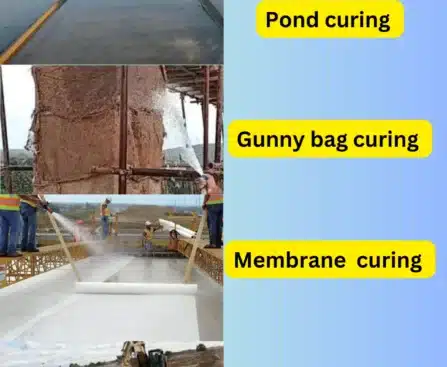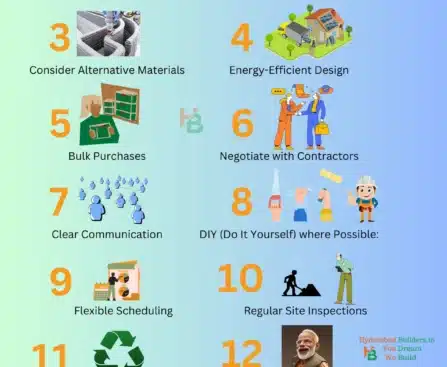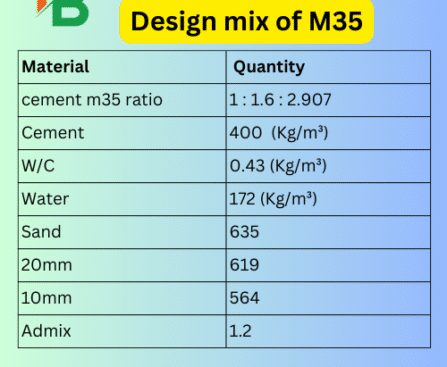Introduction: In every construction, where longevity and structural integrity is important, the often-overlooked process of curing of concrete plays a pivotal role. Curing is more than just a step; it’s a key factor that influences the strength, durability, and overall performance of construction materials, particularly concrete. This article delves into the importance of curing, exploring methods, best practices, and the consequences of neglecting this critical aspect. What is Curing? Curing is the controlled process of maintaining adequate moisture, temperature, and time for concrete or other construction materials to achieve optimal hydration and comprehensive strength. It is the phase where cement reacts with water, forming a strong and durable matrix. Importance of Proper Curing of concrete: Strength Development: Proper curing enhances the hydration process, allowing concrete to achieve its designed strength. Inadequate curing can result in lower strength and compromised structural performance. Durability: Cured concrete is more resistant to environmental factors such as freeze-thaw cycles, chemical exposure, and abrasion, ensuring long-term durability. Crack Prevention: Curing minimizes the likelihood of cracks, safeguarding the structural integrity and aesthetic appeal of constructions. Methods of Curing: Water Curing: Process: Involves submerging the concrete in water or consistently wetting its surface. Effectiveness: Highly effective for preventing moisture loss, particularly crucial during the initial stages of curing. Applications: Widely used for various concrete structures to ensure adequate hydration and strength development. Steam Curing: Process: Accelerates curing by applying heat and steam to the concrete surface. Suitability: Ideal for projects requiring rapid strength development, such as precast concrete elements. Benefits: Shortens the curing period, allowing for faster project timelines and increased production efficiency. Membrane Curing: Application: Apply a curing membrane, such as curing compounds or sheets, to the concrete surface. Procedure: Ensure uniform coverage, and the membrane forms a continuous layer. Purpose: The membrane acts as a barrier, preventing moisture evaporation and creating a controlled curing environment. Considerations: Commonly used when water curing is impractical, such as in windy or hot conditions. Electrical Curing: Installation: Embed electrical resistive elements or wires within the concrete. Activation: Apply electrical currents to generate heat within the concrete. Procedure: Maintain precise control over the temperature to accelerate the curing process. Applications: Commonly used in precast concrete elements or when traditional curing methods are challenging. Curing Period of Concrete: Initiation: Commences immediately after the concrete is placed and finished. Duration: Typically spans a minimum of seven days, but varies based on factors like mix design, ambient conditions, and project requirements. Method: Involves keeping the concrete consistently moist during the specified curing period. Importance: Allows sufficient time for hydration, ensuring the concrete attains the desired strength and durability. Infrared Radiation Curing: Equipment: Use infrared radiation sources, such as lamps or heaters. Procedure: Direct infrared radiation onto specific areas or the entire concrete surface. Advantages: Enables targeted heating, speeding up curing in localized regions. Particularly beneficial in cold weather conditions. Acrylic Compound: Application: Spray or brush the acrylic compound onto the concrete surface. Formation: Forms a protective film that acts as a barrier against water evaporation. Purpose: Retains moisture on the concrete surface, promoting proper curing. Common Use: Applied to exterior concrete surfaces to prevent rapid moisture loss, especially in sunny or windy conditions Chemical Curing: Process: Involves using curing compounds applied to the concrete surface to create a moisture-retaining film. Ideal Applications: Well-suited for large-scale projects where manual curing may be impractical or challenging. Advantages: Ensures uniform curing, reduces labor requirements, and provides a protective layer against premature drying. Best Practices for Concrete Curing: Timely Initiation: Importance: Begin curing immediately after concrete setting to prevent premature moisture loss. Rationale: Early initiation ensures optimal hydration, contributing to the concrete’s long-term strength and durability. Duration and Frequency: Guidelines: Maintain curing for a recommended period, typically a minimum of seven days. Execution: Regularly wet the concrete surface or apply curing compounds to sustain continuous hydration. Objective: Adequate curing duration and frequency are vital for achieving the desired concrete strength and durability. Temperature Considerations: Adaptation: Adjust curing methods based on ambient temperature conditions. Prevention: Avoid curing during extreme weather conditions, such as high winds or direct sunlight, to prevent thermal cracking. Outcome: Proper temperature considerations contribute to the prevention of surface defects and ensure consistent curing results. Consequences of Inadequate Curing: Reduced Strength: Issue: Inadequate curing results in incomplete hydration of cement particles. Effect: Reduced concrete strength, compromising the structural integrity of the construction. Impact: Weakened concrete may lead to structural failures and pose safety risks. Increased Permeability: Problem: Poorly cured concrete is more vulnerable to water penetration. Outcome: Increased permeability, leading to durability issues as water ingress can cause corrosion of reinforcing steel. Concern: Reduced resistance to environmental factors, affecting the long-term performance of the structure. Cracking and Surface Defects: Challenge: Insufficient moisture during curing raises the risk of cracks and surface imperfections. Result: Cracking compromises the aesthetics and functionality of the concrete. Consequence: Structural integrity is compromised, and repairs may be required, increasing maintenance costs.
Cost Effective Construction: Strategies for Smart Budgeting and Quality Results in Hyderabad starting a new construction in Hyderabad? to have cost effect construction without compromising on the quality of your dream home or commercial space is a delicate balance. In this article, we explore practical tips and strategies for cost effective construction that can help you navigate the new construction projects of Hyderabad. 1. Detailed Budget Planning: The foundation of any cost-effective construction project is a through and well planned budget. Break down expenses into categories such as construction materials, design cost, home interior cost, labor cost, building permits, and contingencies. This comprehensive approach ensures that every rupee is accounted for, preventing unforeseen financial hiccups. 2. Research Local Material Prices: In Hyderabad’s thriving construction , a world of construction materials awaits, each with its price range. As Hyderabad is a fast moving city every day construction cost changes. If your planning anew house construction in Hyderabad you need to be updated each and everyday To ensure cost-effective construction, diligent research is key. Compare prices across building materials suppliers, identifying the most economical options without compromising quality. Cultivate relationships with reliable and trustable suppliers to establish a foundation for long-term savings. This strategic approach empowers builders and home owners to make informed decisions, optimizing their construction budgets and achieving quality results in the dynamic markets of Hyderabad.. 3. Consider Alternative Materials: Quality need not always come with a hefty price tag. Explore alternative, cost effective construction materials without compromising structural integrity. Local and recycled materials can offer sustainable choices without breaking the bank. 4. Energy-Efficient Design: Investing in an energy-efficient design not only reduces long-term operational costs but can also make you eligible for government incentives. Consider incorporating green building principles into your plans to enhance cost effective construction . 5. Bulk Purchases: Collaborate with your contractor to make bulk purchases of materials. Many suppliers offer discounts for large orders, helping you save significantly on construction costs. 6. Negotiate with Contractors in Hyderabad: Transparent communication with contractors and builders in Hyderabad is key. Obtain multiple quotes, negotiate prices of each building material take time, and discuss your budget constraints openly with builders and contractors . A well-negotiated contract can lead to a win-win situation for both parties. 7. Clear Communication: Establish clear communication channels with your construction team like construction material suppliers, builders, contactors, labor and local authorities. Transparent discussions about budget constraints and expectations ensure everyone is on the same page, minimizing misunderstandings that can lead to costly errors. 8. DIY (Do It Yourself) where Possible: Taking on smaller tasks yourself, such as painting or landscaping, can contribute to significant savings. Identify areas where your skills align with the project requirements and roll up your sleeves. 9. Flexible Scheduling: Consider flexible construction schedules to take advantage of off-peak seasons. Contractors may offer discounts during less busy periods, allowing you to benefit from cost savings. 10. Regular Site Inspections: Stay actively involved in your house construction process by conducting regular site inspections. Identifying and addressing issues early on can prevent big costly mistakes and delays, ensuring the project stays on budget. 11. Reuse and Recycle: Explore opportunities to reuse materials from existing structures on the site. Additionally, recycling construction waste not only contributes to sustainability but also aids in cost reduction. 12. Government Incentives and Subsidies: Hyderabad often provides incentives and subsidies for eco-friendly construction practices. Research and take advantage of any available government support, which can contribute to substantial cost savings. 13. Compare Quotation and References: Obtain quotes from multiple contractors and thoroughly check their references. Opt for contractors with a proven track record of delivering quality work within budget constraints. 14. Technology for Cost Monitoring: Leverage construction management software and apps to monitor costs in real-time. Embracing new construction technologies enhances project efficiency and helps you stay within budget. 15. Plan for Contingencies: Allocate a portion of your budget for contingencies to account for unforeseen circumstances. This foresight prevents financial strain in the face of unexpected challenges during construction. By integrating these strategies into your construction plan, you can navigate the vibrant construction scene of Hyderabad with confidence. Remember, cost-effective construction is about making informed decisions that balance your budget while achieving the quality results you desire. Happy building! Please like share this article
What is Fly Ash? Fly ash is a fine, powdery byproduct resulting from the combustion of pulverized coal in power plants. It consists of mineral particles that are carried away by flue gases during the combustion process. Composed mainly of silica, alumina, and iron, fly ash is classified as a pozzolanic material. There are two main types: Class F (low-calcium) and Class C (high-calcium), each with specific chemical and physical properties. Applications of Fly Ash: Concrete Admixture: Properties: Reduces cement-aggregate reaction, lowers heat evolution, improves water tightness, enhances plasticity and cohesiveness, and strengthens concrete. Usage: Widely used in concrete, especially for high-strength and high-performance applications. Cellular Concrete Blocks: Properties: Provides a favorable strength-to-weight ratio, good sound insulation, stability against temperature variations, resistance to fire and water, and low thermal conductivity. Usage: Autoclaved cellular concrete blocks are produced by autoclaving a mixture of fly ash and lime, offering technical advantages in construction. Fly Ash Building Blocks: Properties: Manufactured with a mix of fly ash, sand, and lime, resulting in bricks with superior shape, technical specifications, compressive strength, and impermeability. Usage: An eco-friendly alternative to traditional burnt bricks, these blocks are lighter, about 20%, and more cost-effective, contributing to sustainable and economical construction practices. Fly ash’s versatile properties make it a valuable material in various construction applications, promoting both sustainability and efficiency in the building industry. Fly ash brick Size:
M40 Mix design Calculation Grade Designation: M-40 Type of Cement: O.P.C-43 grade Admixture: Fosroc (Conplast SP 430 G8M) Fine Aggregate: Zone-II Specific Gravity: Cement: 3.15 Fine Aggregate: 2.61 Coarse Aggregate (20mm): 2.65 Coarse Aggregate (10mm): 2.66 Minimum Cement (As per contract): 400 kg/m³ Maximum Water-Cement Ratio (As per contract): 0.45 Target Mean Strength: 48.25 MPa Assumed Water-Cement Ratio: 0.4 Assumed Cement Content: 400 kg/m³ (As per contract minimum) Mix Calculation: Target Mean Strength (T.M.S.): 40 + (5 X 1.65) = 48.25 Mpa 2. Selection of water cement ratio:-Assume water cement ratio = 0.4 3. Calculation of cement content: –Assume cement content 400 kg / m3(As per contract Minimum cement content 400 kg / m3) 4. Calculation of water: –400 X 0.4 = 160 kg Which is less than 186 kg (As per Table No. 4, IS: 10262) 5. Calculation for C.A. & F.A.: – As per IS : 10262 , Cl. No. 3.5.1 V = [ W + (C/Sc) + (1/p) . (fa/Sfa) ] x (1/1000) V = [ W + (C/Sc) + {1/(1-p)} . (ca/Sca) ] x (1/1000) Where Absolute Volume of Fresh Concrete (V): Gross Volume (m³) minus the volume of entrapped air. Mass of Water per m³ of Concrete (W): Mass of Water (kg). Mass of Cement per m³ of Concrete (C): Mass of Cement (kg). Specific Gravity of Cement (Sc): Specific Gravity of Cement. Ratio of Fine Aggregate to Total Aggregate by Absolute Volume (p). Total Mass of Fine Aggregate per m³ of Concrete (fa): Total Mass of Fine Aggregate (kg). Total Mass of Coarse Aggregate per m³ of Concrete (ca): Total Mass of Coarse Aggregate (kg). Mix Details per (m³): Material Quantity Cement 400 kg/m³ Water 160 kg/m³ Fine Aggregate 660.2 kg/m³ Coarse Aggregate (20mm) 701 kg/m³ Coarse Aggregate (10mm) 467 kg/m³ Admixture 2.4 kg Recron 3S 900 gm Water-Cement-Fine Aggregate-Coarse Aggregate Ratio: Water : Cement : F.A. : C.A. = 0.4 : 1 : 1.65 : 2.92 Disclaimer: The mix design for M40 grade concrete provided here is for reference only. Actual site conditions vary, and adjustments should be made based on the specific location and other factors.
M35 Mix Design Ratio for Pile Foundations Introduction M35 Grade Concrete: M35 represents the comprehensive strength of the concrete, and in this case, it is 35 MPa. The design involves understanding the specific requirements, adjusting for site conditions, and ensuring the mix meets the necessary criteria for pile foundations. Key Parameters: – Comprehensive Strength (Fck): 35 MPa – Standard Deviation: 1.91 MPa – Target Mean Strength (T.M.S.): 38.15 MPa Test Data for Material Aggregate Type and Specific Gravity – Aggregate Type: Crushed – Specific Gravity: – Cement: 3.15 – Coarse Aggregate: 2.67 – Fine Aggregate: 2.62 Sand Content Taking the sand content as a percentage of total aggregates, it is set at 36%. Water-Cement Ratio M35 concrete ratio The water-cement ratio is a crucial factor in determining the mix design. For M35 grade concrete, a water-cement ratio of 0.43 is chosen, as per IS 10262-1982. Water Content Following the guidelines from IS: 10262, the water content is selected as 172 kg, ensuring it aligns with the specified maximum water content for 20 mm nominal size of aggregates. Cement Content Calculation The cement content is calculated using the water-cement ratio: Cement Content = Water Content / Water-Cement Ratio = 172 / 0.43 = 400 kg/m³ Mix Proportions for Fine and Coarse Aggregate The mix proportions are calculated using the formula for fine and coarse aggregate, considering the specific gravity of the materials and air content: 1000(1-a₀) = ((Cement Content / Sp. Gr. Of Cement) + Water Content + (Fa / Sp. Gr. * Pf)) / ((Cement Content / Sp. Gr. Of Cement) + Water Content + (Ca / Sp. Gr. * Pc)) The resulting fine aggregate (Fa) and coarse aggregate (Ca) are found to be 642 kg/m³ and 1165 kg/m³, respectively. Gradation of Coarse Aggregates Based on the combined gradation, a proportion of 53:47 for 20 mm and 10 mm aggregates produces the best gradation as per IS: 383. 20 mm Aggregates: 619 kg/m³ 10 mm Aggregates: 546 kg/m³ Admixture To achieve the desired slump in the range of 150-190 mm, a water-reducing admixture (SP430 from Fosroc) is recommended. The dosage is set at 0.3% by weight of cement. M35 Mix Design Ratio Table Material Quantity Cement (M35 Ratio) 1 : 1.6 : 2.907 Cement 400 Kg/m³ W/C 0.43 Kg/m³ Water 172 Kg/m³ Sand 635 Kg/m³ 20mm 619 Kg/m³ 10mm 564 Kg/m³ Admixture 1.2 Conclusion A meticulous mix design is crucial for the success of any concrete construction, especially for critical elements like pile foundations. The M35 grade concrete mix design outlined here considers various factors, ensuring the resulting concrete meets strength, durability, and workability requirements. However, it’s essential to note that on-site conditions and specific project requirements may necessitate adjustments to the mix design. In conclusion, a well-designed concrete mix not only ensures the structural integrity of the project but also contributes to the longevity and performance of the structure over time. Related article : Mix design ration M45, Mix design ratio of m40, mix design ratio of M20 Disclaimer: The provided mix design details are for reference. Site conditions may necessitate adjustments.



